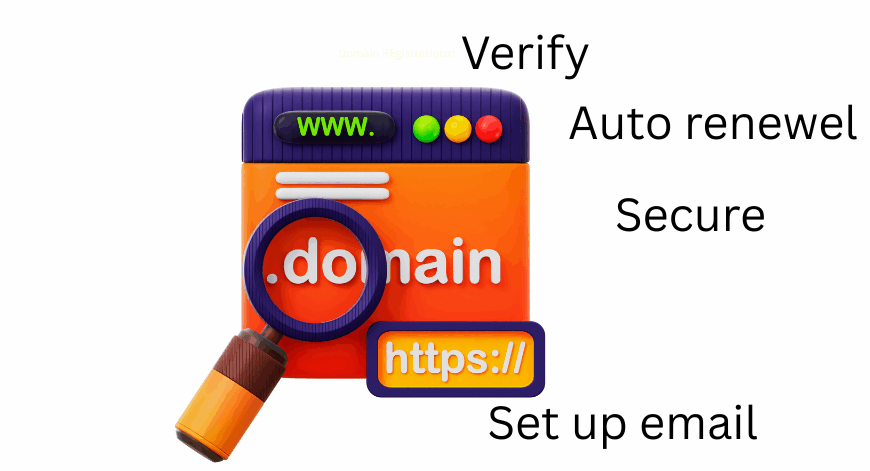Your resume gets 6 seconds of attention from recruiters. That’s it. A portfolio website gives you unlimited time to showcase your work and tell your story.
I’ve reviewed hundreds of job applications. The candidates with portfolio websites always stand out. They show initiative, professionalism, and tech-savviness before the interview even starts.
What You’ll Accomplish in the Next Hour
By following this guide, you’ll build a portfolio website that includes:
- A professional homepage with your photo and bio
- A showcase of your best work samples
- Your contact information and social links
- A mobile-friendly design that looks great everywhere
- Your own custom domain name
No coding required. No design skills needed. Just follow these steps.
I) Choose Your Domain Name (5 Minutes)

Your domain name is your online address. Make it memorable and professional.
Picking the Perfect Name
Use your actual name if possible. “JohnSmithDesign.com” beats “CoolDesigner2024.com” every time.
If your name is taken, try these options:
- Add your profession: JohnSmithWriter.com
- Use your middle initial: JohnMSmith.com
- Try .co or .design extensions
Keep it short. Easy to spell. Easy to remember.
II) Get Website Hosting with a Builder (10 Minutes)

To build a portfolio website, you need two things. A place to store your site (hosting) and tools to create it (website builder).
Why Website Builders Beat Coding
Website builders let you drag and drop elements. You see exactly what you’re creating in real-time. No HTML, CSS, or confusing code required.
Visit Truehost to get started. They offer affordable hosting plans with built-in website builders. Their starter plans include everything you need for under $10 monthly.
What to Look for in Hosting
| Feature | Why It Matters |
|---|---|
| Website builder included | Build without coding |
| Free SSL certificate | Makes your site secure |
| Mobile-responsive templates | Looks good on phones |
| One-click install | Get started fast |
Most shared hosting plans include website builders. You don’t need expensive premium hosting for a portfolio website.
III) Select Your Template (5 Minutes)
Templates are pre-designed layouts you customize. They save you hours of design work.
Choosing the Right Template
Pick a template that matches your industry. Creative professionals need visual templates. Writers need text-focused layouts. Developers need clean, minimal designs.
Template selection tips:
- Choose simple over flashy
- Ensure it has portfolio/gallery sections
- Check if it’s mobile-responsive
- Pick light backgrounds for readability
Your website builder will have dozens of templates. Don’t overthink this step. You can always change templates later.
IV) Customize Your Homepage (15 Minutes)

Your homepage makes the first impression. Get this right and visitors will explore further.
Essential Homepage Elements
Professional Photo Use a clear headshot or professional photo. Smile naturally. Dress like you would for an interview. This builds trust immediately.
Compelling Headline Tell visitors what you do in one sentence. “Graphic Designer Specializing in Brand Identity” beats “Welcome to My Site.”
Brief Bio Write 2-3 sentences about yourself. Mention your expertise, experience, and what makes you unique. Keep it conversational and genuine.
Writing Your Bio
I always recommend the problem-solution format. “I help [target audience] achieve [desired outcome] through [your skills].”
Example: “I help startups build memorable brands through strategic design and storytelling.”
Keep it simple. Avoid jargon. Write like you’re talking to a friend.
V) Create Your Portfolio Section (20 Minutes)
This is why you’re building a portfolio website. Showcase your absolute best work here.
How Many Projects to Include
Quality beats quantity every time. Show 6-10 of your best projects. Each one should demonstrate different skills or styles.
For each project, include:
- High-quality images or screenshots
- Project title and brief description
- Your specific role and contribution
- Results or outcomes when possible
- Links to live projects if available
Organizing Your Portfolio
Group similar projects together. Create categories like “Web Design,” “Branding,” or “Writing Samples.” This helps visitors find relevant work quickly.
Use your website builder’s gallery or portfolio blocks. Most builders let you drag and drop images. Add text descriptions below each project.
VI) Add an About Page (5 Minutes)
Your About page builds connection. Employers want to work with real people, not robots.
What to Include
Your Story How did you get into your field? What drives you? Keep it authentic and brief.
Your Skills List your top 5-8 skills. Be specific. “Adobe Photoshop” is better than “Design Software.”
Your Experience Mention relevant jobs, education, or training. You don’t need to list everything from your resume here.
Personal Touch Add something human. Hobbies, interests, or fun facts make you memorable. Just keep it professional.
VII) Create a Contact Page (3 Minutes)
Make it ridiculously easy for employers to reach you. Every barrier you remove increases your chances of getting hired.
Contact Page Essentials
Add a simple contact form using your website builder’s form feature. Most builders include this by default.
Must-have information:
- Email address
- LinkedIn profile link
- Phone number (optional)
- Location (city/state is enough)
Include links to relevant professional social media. GitHub for developers. Behance for designers. Medium for writers.
VIII) Optimize for Mobile Devices (2 Minutes)
Over 60% of web traffic comes from mobile devices. Your portfolio website must look perfect on phones.
Quick Mobile Check
Most modern website builders create mobile-responsive sites automatically. But always check yourself.
Preview your site on mobile using your builder’s preview feature. Look for:
- Text that’s too small to read
- Images that don’t fit the screen
- Buttons too small to tap
- Menus that don’t work properly
Fix any issues before publishing. This takes just a few minutes with drag-and-drop builders.
IX) Add Finishing Touches (3 Minutes)
Small details separate amateur sites from professional ones. These quick additions make a big difference.
Professional Elements to Add
Favicon That tiny icon in browser tabs. Use your initials or a simple logo. Your website builder has a section for uploading this.
Social Proof Add testimonials from previous clients or employers if you have them. Even one strong testimonial builds credibility.
Clear Navigation Keep your menu simple. Home, Portfolio, About, Contact. That’s usually enough for a portfolio website.
X) Publish Your Site (2 Minutes)
You’ve built your portfolio website. Now make it live for the world to see.
The Publishing Process
Hit the publish button in your website builder. That’s literally it. Your site goes live immediately.
Most builders at Truehost make publishing a one-click process. No complicated configurations or technical steps required.
After publishing:
- Visit your domain to confirm it works
- Test all links and buttons
- Send the link to a friend for feedback
- Share on your LinkedIn profile
Common Mistakes to Avoid
I’ve seen hundreds of portfolio websites. These mistakes appear repeatedly and hurt your chances of getting hired.
Don’t Make These Errors
a) Including Too Much Only show your best work. Ten mediocre projects hurt more than five excellent ones.
b) Forgetting Contact Information Seems obvious, but many people forget easy ways to reach them. Make contact effortless.
c) Using Generic Stock Photos Stock photos look fake. Use real images of your work. Real photos of yourself. Authenticity wins.
d) Ignoring Spelling and Grammar Typos make you look careless. Proofread everything. Then proofread again. Use free tools like Grammarly to catch errors.
e) Leaving Placeholder Text Remove all “Lorem ipsum” and example text. It screams “unfinished” louder than having no website at all.
Maintaining Your Portfolio Website
Building your portfolio website takes an hour. Keeping it current takes 15 minutes monthly.
Monthly Maintenance Checklist
- Add new projects as you complete them
- Remove outdated work samples
- Update your bio with new skills or achievements
- Check all links still work
- Review and respond to contact form messages
Set a calendar reminder for the first of each month. This keeps your portfolio fresh and relevant.
What Employers Look for in Portfolio Websites
I’ve hired dozens of people based partly on their portfolios. Here’s what catches my attention.
The Winning Formula
Clarity I should understand what you do within 5 seconds. Clear headlines and obvious navigation make this happen.
Quality Work One amazing project beats ten average ones. Curate ruthlessly. Only show work you’re genuinely proud of.
Professionalism Clean design, proper grammar, professional photo. These basics matter more than fancy features.
Personality Your website should feel like you. Generic portfolios are forgettable. Authentic ones get remembered and shared.
Industry-Specific Portfolio Tips
Different fields need different approaches when you build a portfolio website. Customize your site for your industry.
For Designers
Show process, not just final results. Include sketches, iterations, and explanations. This demonstrates thinking, not just execution.
For Writers
Include diverse samples showing range. Blog posts, articles, case studies, and different tones. Always proofread obsessively.
For Developers
Include live project links and GitHub repositories. Show clean code samples. Explain your technical choices.
For Marketers
Display measurable results. “Increased engagement 300%” beats “Managed social media.” Numbers prove impact.
Taking It Further
You’ve built your basic portfolio website. These optional additions can strengthen it further.
Advanced Features to Consider
Blog Section Share industry insights or document your learning journey. This demonstrates ongoing growth and expertise.
Case Studies Deep-dive into 2-3 major projects. Explain challenges, solutions, and results. This showcases strategic thinking.
Testimonials Page Collect recommendations from clients, coworkers, or professors. Social proof builds trust quickly.
Your website builder makes adding these sections simple. Most offer pre-built blocks you customize with your content.
The Cost Breakdown
Building a portfolio website costs less than most people think. Here’s the honest pricing.
| Expense | Cost |
|---|---|
| Domain name | $10-15/year |
| Hosting with builder | $5-10/month |
| Premium template (optional) | $0-50 one-time |
| Stock photos (optional) | $0-30/month |
| Total Year One | $70-$200 |
Most professionals recoup this investment with their first job opportunity. The return on investment is massive.
Why Website Builders Beat Custom Coding
Some people think custom-coded sites are more impressive. They’re wrong for portfolio websites.
Website builders offer:
- Professional designs instantly
- Mobile responsiveness automatically
- Regular security updates
- Easy content updates
- No technical knowledge required
Your portfolio should showcase your professional skills. Not your coding abilities (unless you’re a developer).
Start Building Your Portfolio Website Now
You have everything you need to build a portfolio website that gets you hired. The tools exist. The process is simple. The cost is minimal.
The only thing missing is your action. Every day without a portfolio website is a day of missed opportunities.
Take these steps right now
Your future employer is searching for someone like you. Make sure they can find you. Build your portfolio website today and watch new opportunities appear.
The difference between you and hired candidates? They have portfolio websites. Join them in the next 60 minutes.



